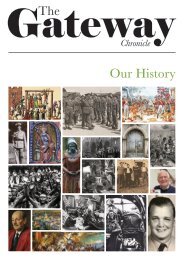You also want an ePaper? Increase the reach of your titles
YUMPU automatically turns print PDFs into web optimized ePapers that Google loves.
23<br />
Wars of the Roses had significantly weakened<br />
the nobility due to the great killings<br />
that took place between noble families.<br />
It is tempting to say that Henry was the<br />
founder of this new<br />
kingship. After all,<br />
1485 marked the end<br />
of the ‘Wars of the<br />
Roses’ and brought a<br />
new dynasty to the<br />
throne. A new period<br />
of history, the<br />
Tudors, had begun and therefore surely<br />
that’s where the new style of kingship begun.<br />
New kingship, New England.<br />
In fact, however, Henry VII had probably<br />
drawn on Edward IV’s example of inform<br />
his new monarchy. During his second<br />
time on the throne, Edward IV had also<br />
employed a similar style of kingship. He<br />
had not fought foreign battles repeatedly.<br />
Instead, he went to France with an army<br />
“Henry VII shaped, crafted and<br />
accentuated the new kingship”<br />
began the use of spies, which he made<br />
great use of in 1466 to capture Henry VI.<br />
But maybe the original creator of this<br />
kingship came from a man nearly a century<br />
before Henry<br />
VII’s reign. Richard<br />
II was often seen as<br />
an unsuccessful and<br />
inept monarch who<br />
was deposed in 1399.<br />
Yet his style of kingship<br />
was certainly<br />
completely different to previous English<br />
monarchs. He pursued peace with France,<br />
which he achieved through his 1396 marriage<br />
that gave him a 28-year truce and<br />
£130 000. This made him less reliant on<br />
Parliament which he took great pleasure<br />
in not having to be dependent on anymore.<br />
He most certainly tried to bully the<br />
nobility. He forced the nobles to sign<br />
away all their lands to him in the late<br />
1390s and in 1397 killed three nobles who<br />
had angered him ten years back. He<br />
was trying to send a message to the nobility<br />
which conveyed his strength<br />
over them and his toughness against<br />
them. While his bullying ultimately<br />
backfired when Henry Bolingbroke,<br />
who he had expelled and disinherited,<br />
usurped him. But some aspects of his<br />
strategy such as peace with France was<br />
observed and acted upon by his successors<br />
many years later.<br />
Commemorative plaque<br />
for Cornish Rebellion in but came back with a treaty in<br />
Cornish and English, 1475 which gave him more<br />
Blackheath Common money and one less threat. Rather<br />
than relying on Parliament<br />
for money to pay off the debts left by his<br />
predecessors through taxation, he also relied<br />
on forced gifts which made Parliament<br />
less controlling. It was he who<br />
Henry VII’s son, Henry VIII, would<br />
build on his father’s legacy by breaking<br />
with Rome, furthering the power<br />
of the king – an incredibly significant<br />
milestone in changes to kingship.<br />
Henry VII certainly shaped, crafted<br />
and accentuated the ‘new kingship’.<br />
But it was not his creation entirely. Richard<br />
II and, more importantly, Edward IV<br />
were in fact significant players too in the<br />
foundation of this new style of monarchy.<br />
Sam OA


















